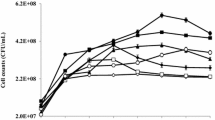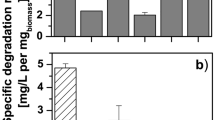Abstract
The metabolism of the organophosphonate herbicide glyphosate was investigated in 163 environmental bacterial strains, obtained by a variety of isolation strategies from sites with or without prior exposure to the compound. Isolates able to use glyphosate as sole phosphorus source were more common at a treated site, but much less abundant than those capable of using the glyphosate metabolite aminomethyl-phosphonic acid (AMPA). Nevertheless, all 26 strains found to metabolise the herbicide did so via an initial cleavage of its carbon-phosphorus bond so via an initial cosine; no evidence for its metabolism or co-metabolism to AMPA was obtained.
Similar content being viewed by others
References
Balthazor TM, Hallas LE (1986) Glyphosate-degrading microorganisms from industrial activated sludge. Appl Environ Microbiol 51:432–434
Collins VG, Willoughby LG (1962) The distribution of bacteria and fungal spores in Blelham Tarn with particular reference to an experimental overturn. Arch Microbiol 43:294–307
Dick RE (1991) Microbial degradation of the herbicide glyphosate. PhD Thesis, The Queen's University of Belfast, Belfast, N. Ireland
Hallas LE, Hahn EN, Korndorfer C (1988) Characterization of microbial traits associated with glyphosate degradation in industrial activated sludge. J Ind Microbiol 3:377–385
Horvath RS (1972) Microbial co-metabolism and the degradation of organic compounds in nature. Bacteriol Rev 36:146–155
Jacob GS, Garbow JR, Hallas LE, Kimak NE, Kishore GH, Schaeffer J (1988) Metabolism of glyphosate in Pseudomonas sp. strain LBr. Appl Env Microbiol 54:2953–2958
Kishore GH, Jacob GS (1987) Degradation of glyphosate by Pseudomonas sp. PG2982 via a sarcosine intermediate. J Biol Chem 262:12164–12168
Krieg NR (1981) Enrichment and isolation. In: Gerhardt P (ed) Manual of methods for general bacteriology. ASM, Washington, pp 112–142
Lee K-S, Metcalf WW, Wanner BL (1992) Evidence for two phosphonate degradative pathwaysin Enterobacter aerogenes. J Bacteriol 174:2501–2510
Lerbs W, Stock M, Parthier B (1990) Physiological aspects of glyphosate degradation in Alcaligenes spec. strain GL. Arch Microbiol 153:146–150
Liu C-M, McLean PA, Sookdeo CC, Cannon FC (1991) Degradation of the herbicide glyphosate by members of the family Rhizobiacae. Appl Environ Microbiol 57:1799–1804
Malik J, Barry G, Kishore G (1989) The herbicide glyphosate (minireview). Biofactors 2:17–25
McAuliffe KS, Hallas LE, Kulpa CF (1990) Glyphosate degradation by Agrobacterium radiobacter isolated from activated sludge. J Ind Microbiol 6:219–221
Murthy DVS, Irvine RL, Hallas LE (1989) Principles of organism selection for the degradation of glyphosate in a sequencing batch reactor. In: Bell JM (ed) 43rd Annual Purdue Industrial Waste Conference. Lewis, Chelsea, Mich
Pipke R, Amrhein N (1988) Degradation of the phosphonate herbicide glyphosate by Arthrobacter atrocyaneus ATCC 13752. Appl Environ Microbiol 54:1293–1296
Pipke R, Amrhein N, Jacob GS, Schaeffer J, Kishore GM (1987) Metabolism of glyphosate in an Arthrobacter sp. GLP-1. Eur J Biochem 165:267–273
Quinn JP, Peden JMM, Dick RE (1988) Glyphosate tolerance and utilization by the microflora of soils treated with the herbicide. Appl Microbiol Biotechnol 29:511–516
Quinn JP, Peden JMM, Dick RE (1989) Carbon-phosphorus bond cleavage by gram-positive and gram-negative soil bacteria. Appl Microbiol Biotechnol 31:283–287
Rueppel ML, Brightwell BB, Schaeffer J, Marvel JT (1977) Metabolism and degradation of glyphosate in soil and water. J Agric Food Chem 25:517–528
Shinabarger DL, Braymer HD (1986) Glyphosate catabolism by Pseudomonas sp. strain PG2982. J Bacteriol 168:702–707
Sprankle P, Meggitt WF, Penner D (1975) Adsorption, mobility, and microbial degradation of glyphosate in the soil. Weed Sci 23:229–234
Torstensson L (1985) Behavior of glyphosate in soils and its degradation. In: Grossbard E, Atkinson D (eds) The herbicide glyphosate. Butterworth, London, pp 137–150
Verveij A, Boter HL, Dagenhardt CEAM (1979) Chemical warfare agents: verification of compounds containing the phosphorus-methyl linkage in waste water. Science 204:616–618
Wanner BL, Metcalf WW (1992) Molecular genetic studies of a 10.9-kbp operon in Escherichia coli for phosphonate uptake and biodegradation. FEMS Microbiol Lett 100:133–140
Weidhase R, Albrecht B, Stock M, Weidhase RA (1990) Glyphosatverwertung durch Pseudomonas sp. GS. Zentralbl Mikrobiol 145:433–438
Author information
Authors and Affiliations
Rights and permissions
About this article
Cite this article
Dick, R.E., Quinn, J.P. Glyphosate-degrading isolates from environmental samples: occurrence and pathways of degradation. Appl Microbiol Biotechnol 43, 545–550 (1995). https://doi.org/10.1007/BF00218464
Received:
Revised:
Accepted:
Issue Date:
DOI: https://doi.org/10.1007/BF00218464




